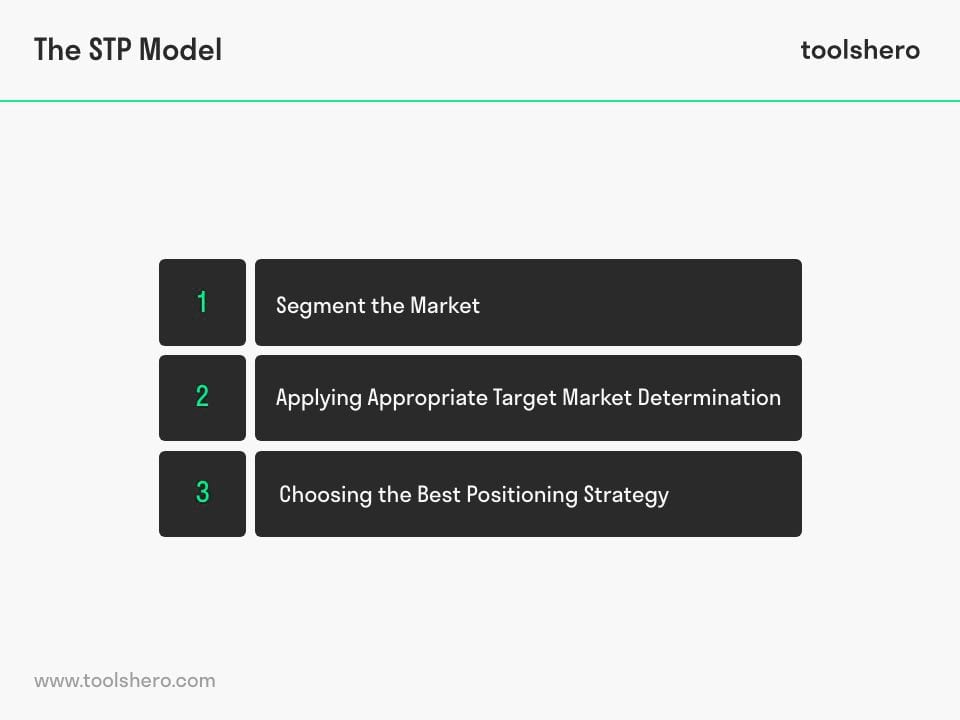STP Model in Marketing Explained: Steps & Repositioning Example

STP model: this article explains the STP model in a practical way. Next to what it is, this artcile also highlights the basis steps of the framework and what repositioning is including ana famous example of the brand Coca Cola. After reading it, you will understand the basics of this powerful marketing tool. Enjoy reading!
What is the STP model?
The STP model is a framework for positioning a company or brand. STP is an abbreviation that stands for Segmentation, Targeting and Positioning. This framework is mainly used to map out which segments of the market have the most potential and which positioning strategy best aligns with this. The goal here is a general marketing goal: to be able to approach and serve the customer in an optimal way.
This approach consists of 3 steps:
- Segmenting the market
- Applying the appropriate target market
- Choosing the best positioning strategy
It is a summary of some parts of a strategic marketing plan and is often used in a business plan, among others. The STP model offers a clear and schematic overview of the entire process. Going through the positioning strategy step by step ensures that the customer is once again the focus of each step.

Figure 1 – STP model, the basic steps
1. Segmentation
The first step of the STP model in marketing is segmentation. Segmentation is dividing the target market into approachable groups. Market segmentation thus creates subgroups of a market based on demographic characteristics, need characteristics, priorities or common interests, and other psychographic criteria.
By actually understanding the target audience, effective targeting can be performed in sales and marketing strategies.
The benefits of market segmentation are worthwhile. Companies that are effective in their market segmentation make on average 10% more profit than companies whose segmentation is ineffective. This is according to a study by Bain & Company.
Effective customer segmentation allows companies to deliver a stronger and more accurate marketing message toward potential customers with their marketing campaign. One no longer has to be generic and general, but can communicate on an almost personal level. This is possible because the company really understands the wants, needs and characteristics of the target market.
2. Targeting within the STP Model
Targeting or target market selection are terms often associated with the development and launch of new products and brands. It is an important phase in the development of a product or service, because it determines the marketing mix and marketing strategy and contributes to success.
These processes mainly involve evaluating how profitable different segments in the market would be and which of the segments will yield the best return. It is also important to analyze how much time it takes to successfully penetrate the market.
Targeting is performed immediately after the first step of thos approach. The consumer has already been analyzed and categorized into different categories. Now it is important that the most lucrative segment is selected. This market can be characterized by better margins and long-term sustainability.
Competition must also be considered when it comes to targeting. The success of a product largely depends on how well a brand can take market share from its competitor.
The main aspects of this phase are:
- Determine the attractiveness of a particular segment and link it to a company’s objectives, capabilities and resources
- Determine the suitability of a segment that fits the long-term goals of a company
3. Positioning within the STP Model
The third part of this approach focuses on the positioning of a brand or product. This process will not start until the previous phases have been completed. Without the information obtained in the first two steps, it is very difficult to position effectively.
In marketing terms, positioning is the conscious linking of a brand or product to a particular identity or image with different characteristics. The aim of this is to get a spot in the mind of the consumer.
That seems difficult, but it doesn’t have to be. Think about how customers will see your brand or company. What are its strengths, or USPs? What is the added value of your brand compared to the competitor’s brand? Which way of communicating is appropriate for your brand and target group? These are some questions to answer when thinking about positioning your brand.
There are different types of positioning strategies. Some examples are:
- Product features and benefits: associating the brand/product with certain favorable values
- Product quality: associating the brand with high quality and exclusivity
- Product price: associating the brand with competitive prices
- Product use or application: associating the brand with specific uses
Good positioning can provide a competitive advantage. If a brand always offers a little more than the competition when it comes to positioning, consumers will end up choosing that brand more often.
What is repositioning?
Repositioning a brand in the market happens when a company changes its existing status in the market. Repositioning is usually done when performance is below par or when there are major changes in the market. It also happens that companies make the decision to launch a new product or brand instead. They often do this because repositioning a brand entails high costs.
An example of a brand that has done this successfully is Mother Energy Drinks, a brand of The Coca-Cola Company. This company launched Mother Energy Drinks in the Australian market in 2006. The launch was professionally executed and Coca-Cola’s distribution channels were used to get the drinks to the retailers. The taste of the drink was disappointing and the company saw sales numbers fall again and again.
So the company had to make a choice: improve and reposition the product or take it off the market and start a new drink. In the end, it was decided to reposition the product as it already enjoyed a high level of brand awareness.
The biggest challenge for Coca-Cola thus became to regain consumer confidence and let them try the product. This was successful and the brand gained a healthy market share.
Now it is your turn
What do you think? Do you recognize the explanation about the STP model? Is this approach used in your marketing environment? Do you see similarities with other positioning theories? Which part of this model do you think is most important?
Share your experience and knowledge in the comments box below.
More information
- Copulsky, J. R., & Wolf, M. J. (1990). Relationship marketing: positioning for the future. Journal of Business Strategy, 11(4), 16-20.
- Domzal, T., & Unger, L. (1987). Emerging positioning strategies in global marketing. Journal of Consumer Marketing.
- Brooksbank, R. (1994). The anatomy of marketing positioning strategy. Marketing Intelligence & Planning.
How to cite this article:
Janse, B. (2022). STP Model in Marketing. Retrieved [insert date] from Toolshero: https://www.toolshero.com/marketing/stp-model/
Published on: 09/13/2022 | Last update: 04/15/2024
Add a link to this page on your website:
<a href=”https://www.toolshero.com/marketing/stp-model/”>Toolshero: STP Model in Marketing </a>












